by Mary Bailey
Third leaf refers to a crucial time in a vine’s life. The vine is four years old, it’s starting to produce fruit, and you could get a crop. For the long-term health of the vine, according to Sandra Oldfield, sometimes it’s better to sit and wait.
What wineries do in the first five years will also define them, not that anyone is suggesting they sit and wait. Here is a snapshot of three emerging high-quality Okanagan operations—Tyler Harlton, TH Wines, a garagiste in Summerland; Alan Dickinson and family at Synchromesh Wines, Okanagan Falls; and Culmina Family Estate Winery on the Golden Bench in the southern Okanagan. Three different terroir and wine philosophies, three examples of getting it right.
Culmina Family Estate Winery

Culmina Family Estate Winery
“How high up are we?” I ask Donald Triggs, who is slowly pointing the truck straight uphill, or so it seems. We’re on a typical vineyard track, narrow, rutted, stony, on the way to Culmina’s Margaret’s Bench Vineyard, the uppermost block (about 600 metres) planted in Chardonnay, Riesling and Gruner Veltliner.
It may seem counterintuitive to have to go up to find the right vineyard conditions in the cool climate Okanagan. But if you are at Culmina, the Trigg’s family property in the south Okanagan, you have to go up if you want to plant Gruner. The slightly cooler temperatures and schist mountain soils are ideally suited to the grape.
Donald Triggs has had the penultimate career in the wine business. He and Allan Jackson managed the employee buy-out of Chateau Gai from parent company Labatt’s, creating Vincor, then grew Vincor into the world’s eighth largest wine company, with operations in North America, Europe, Australia and New Zealand. It’s not unreasonable to say that Don Triggs essentially created the modern Canadian wine industry. In the almost two decades before Vincor was gobbled up by Constellation Brands, Don’s leadership and vision as CEO created opportunity and career paths for countless viticulturalists, cellar workers, winemakers, and front-office people.
This is different. Culmina is family legacy, no compromise, he gets to do it his way. Well, actually, their way. Elaine, Don’s wife and daughter Sara play significant roles in this venture and Don wouldn’t have it any other way.
“We wanted to take on the challenge of Cabernet Sauvignon,” says Don. “To do that we needed 1,600 degree days (a measurement of both temperature and hours of light used in viticulture to determine ripening possibilities), to consistently ripen Bordeaux varieties. We looked at five different sites from Naramata to the US border.”
The vineyard blocks at Culmina were meticulously planned down to each individual vine. What took European farmers decades of on-the-ground observation, Culmina is doing with sophisticated geo-science.
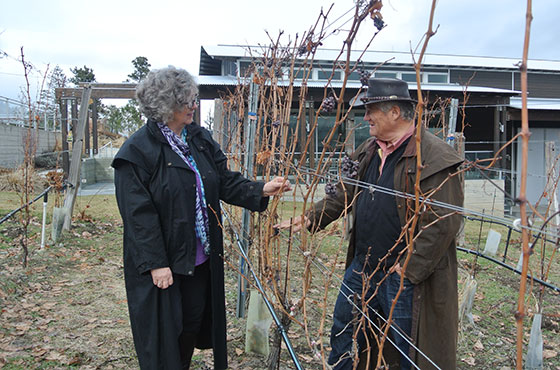
Donald and Elaine Triggs
“We did two years of study before we planted a vine. We examined temperature and satellite data, dug 26 soil pits and had them tested. Where there was elevated calcium, we put the Cab Franc, where there was mountain shadow, we planted Merlot. We have 56 acres on three benches, and to optimize the nuances we practise micro-block farming with five different rootstocks best suited to each soil type. We brought new technology to Canada and better instrumentation to measure soil moisture.”
All this to make sure the vine’s roots go deep to get the water and nutrients it needs to create flavour.
“We know water is going to be an issue in the Okanagan from Department of Enviroment studies. We have started a dry land farming project, planting bush vines of Syrah in areas too steep for tractors. We’ll water for two years only, to establish the vines.”
Why Gruner?
“Consumers are on a journey of discovery. First it was blends, then varietals, now back to blends. They want to try new things. We have the ideal site on Margaret’s Bench as Gruner likes schisty mountain soils, not rounder stones, but the jagged stones that have just broken off from the bedrock. Karl Kaiser had a small block of Gruner at Inniskilliin, it’s winter hardy, even more so than Chard and Riesling.”
“Our signature red, Hypothesis, is our proposal from the vineyard. We’ve been growing premium fruit in the Okanagan for 30 years. Can we raise the bar again? That is the challenge we will meet.”
Synchromesh Wines Inc.
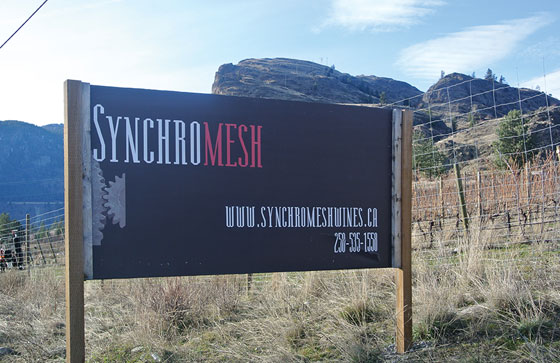
Synchromesh Wines Inc.
“I worked in wine brokerage and acquisition in Vancouver,” says Alan Dickenson, proprietor of Synchromesh. “I was lucky, there were generous collectors who shared—I fell in love with the Rieslings by producers like Donhoff and von Schubert and wanted to make wines like them, terroir-driven natural wines.
“Amy and I bought this property (Storm Haven) which has a southern exposure and complex soils, primarily glacial till and volcanic, which is ideal for Riesling.”
Down the road is Meyer Family Vineyards, makers of pitch-perfect Chardonnay and Pinot Noir.
“Meyer and our property have the same soil; it’s not found anywhere else in the Okanagan Falls area; Painted Rock and Pentage (near Penticton) have it too.”
“Our property follows biodynamic principles—we’re small, so we pretty much do it all ourselves, with parents helping out. In 2011 we built the winery and finished our house last year.”
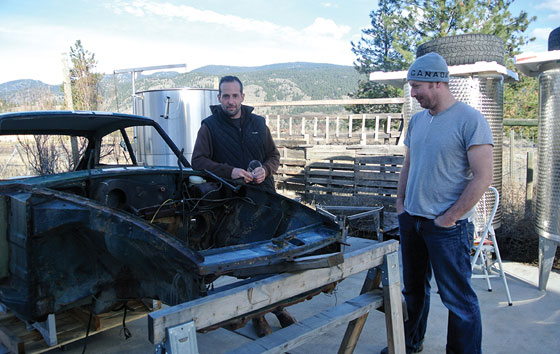
Alan Dickenson’s other love, vintage motor sports
Along with making a subtle Pinot Noir and a well-structured Cab Franc blend call Tertre, Synchromesh makes five Rieslings. The 2013 Storm Haven has a juicy minerality, a vibrancy, with layers of flavours and the promise of more complexity to come with maturity.
“It’s in its ninth leaf,” says Alan, “small production, one ton per acre. The 2011 won the Governor General’s award.”
With wines like these, Syncromesh joins the line-up of exceptional Riesling producers such as Tantalus, Little Farm, Martin’s Lane and Cedar Creek.
Dickenson looked carefully for vineyards they could lease and actively farm to achieve the fruit they wanted, in some cases convincing conventional farmers to become more sustainable. The reds are grown on two sites near Naramata and Oliver, the Pinot Noir on the east side of the lake near Kelowna.
After our visit, I take Alan’s suggestion and drive the McLean Creek Road back to Penticton. It is beautiful—views of ranchland through scrubby pine, gnarly rock, horses grazing in fields with old barns. It’s the old central Okanagan, not the one of golf courses and vacation homes (and vines). While I drive, I’m thinking about that Riesling and the enormous pleasure it offered for such a small investment.
TH Wines
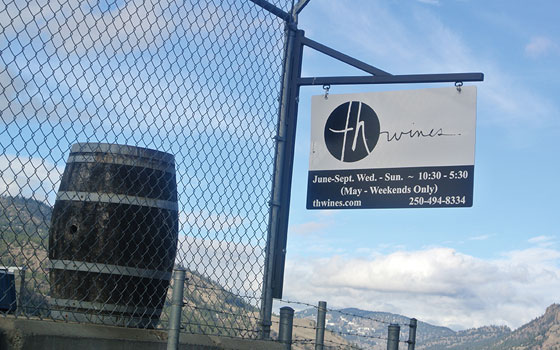
TH Wines
There is an infectious Mickey Roooney-esque let’s-put-on-a-show enthusiasm about Tyler Harlton. Here’s a guy making wine by hand in a garage on the edge of Summerland, and he’s having the time of his life.
“During law school in Montreal I did a semester in Paris. I would spend the weekends in vineyards, in Bordeaux, Alsace, Burgundy—I picked Meursault but didn’t know it at the time. I learned that wine is an expression of agriculture. I decided I wanted to make wine, not practise law. My first job was picking at Osoyoos Larose.”
“We just completed the fourth vintage. I had no money for equipment at first and now we just prefer to do most things by hand.”
What he does have is a small press, some tanks (named Dief the Chief, Riel and Dumont by the way) and a rack of neutral French oak barrels in an industrial bay. It’s not as bleak as it sounds, Giant’s Head Mountain is right outside the door of the small tasting room he built last year. TH owns no vineyards but has created working relationships with several farmers.
“There is more fruit available to me now, especially in Summerland and Osoyoos, probably because I know more growers and winemakers now. I buy the cab franc from a grower in Naramata. We will go and pick early and bring the grapes back and make the wine. I prefer smaller ferments as each brings something unique, that’s where we get complexity. We have no temperature control, we move tanks in and outside when we need to.”
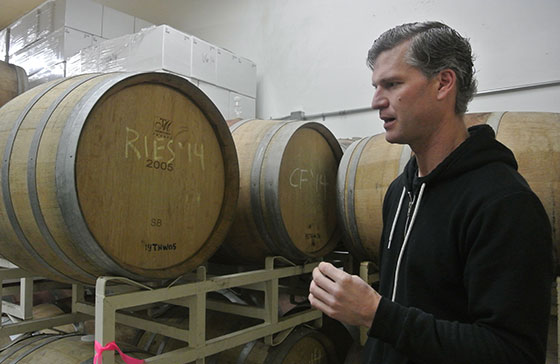
Tyler Harlton
Tyler makes a Pinot Noir, a deliciously structured Cabernet Franc-Merlot, a Pinot Gris-Viognier blend, a sprightly Cabernet Franc rosé and 173 cases of Viognier.
“I love Viognier,” he says. “I found the best grapes out there, two and a half tons per acre, we harvest it in about four hours, then let it sit overnight. The next day we put it in a few barrels and a tank.
“Matt at Blue Mountain is my mentor because they started as growers, and are still involved in every part of their operation—from pruning to disgorging.”